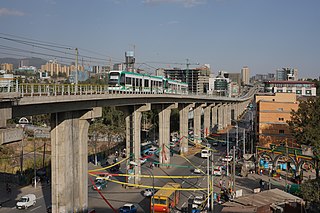Transport in Ethiopia is overseen by the Ministry of Transport and Communications. Over the last years, the Ethiopian federal authorities have significantly increased funding for rail and road construction to build an infrastructure, that allows better economic development.

The Omo River in southern Ethiopia is the largest Ethiopian river outside the Nile Basin. Its course is entirely contained within the boundaries of Ethiopia, and it empties into Lake Turkana on the border with Kenya. The river is the principal stream of an endorheic drainage basin, the Turkana Basin.

Rail transport in Ethiopia is done within the National Railway Network of Ethiopia, which is mostly in planning and construction stage and currently consists of four electrified standard gauge railway lines: the Addis Ababa Light Rail, the Addis Ababa–Djibouti Railway, the Awash–Weldiya Railway and the Weldiya–Mekelle Railway.
This is a list of rulers and office-holders of Ethiopia.
Gilgel Gibe River is a major tributary of the larger Gibe River in southwest Ethiopia in western Oromia Region. It flows in an arc through the south of the Jimma Zone, defining part of the Zone's boundary with that of the Southern Nations, Nationalities, and Peoples' Region as it turns north. It then joins the eastwards flowing Gibe River less than ten miles from its own confluence with the Omo River.

The Ethio-Djibouti Railway (French: Chemin de Fer Djibouto-Éthiopien is a metre gauge railway in the Horn of Africa that once connected Addis Ababa to the port city of Djibouti. The operating company was also known as the Ethio-Djibouti Railways. The railway was built in 1894–1917 to connect the Ethiopian capital city to the then-French colony of Djibouti. During early operations, it provided landlocked Ethiopia with its only access to the sea. After World War II, the railway progressively fell into a state of disrepair due to competition from road transport.
ELC Electroconsult (ELC) is a historic Italian engineering firm established in 1955 by the major Italian private companies leading and pioneering since 1905 in planning, design and construction of hydropower schemes in the Alps. The company is based in Milan (Italy).

The Gilgel Gibe I Dam is a rock-filled embankment dam on the Gilgel Gibe River in Ethiopia. It is located about 57 km (35 mi) northeast of Jimma in Oromia Region. The primary purpose of the dam is hydroelectric power production. The Gilgel Gibe I hydroelectric powerplant has an installed capacity of 184 MW, enough to power over 123,200 households. The dam is 1,700 m (5,600 ft) long and 40 m (130 ft) tall. Construction on the dam began in 1988 but work was halted in 1994. In 1995 construction restarted with a new construction firm. The power station was commissioned in 2004.

The Gilgel Gibe III Dam is a 250 m high roller-compacted concrete dam with an associated hydroelectric power plant on the Omo River in Ethiopia. It is located about 62 km (39 mi) west of Sodo in the Southern Nations, Nationalities, and Peoples' Region. Once fully commissioned, it will be the third largest hydroelectric plant in Africa with a power output of about 1870 Megawatt (MW), thus more than doubling total installed capacity in Ethiopia from its 2007 level of 814 MW. The Gibe III dam is part of the Gibe cascade, a series of dams including the existing Gibe I dam and Gibe II power station as well as the planned Gibe IV and Gibe V dams. The existing dams are owned and operated by the state-owned Ethiopian Electric Power, which is also the client for the Gibe III Dam.

The Gilgel Gibe II Power Station is a hydroelectric power station on the Omo River in Ethiopia. It is located about 80 km (50 mi) east of Jimma in Oromia Region. The power station receives water from a tunnel entrance 7°55′27″N37°23′16″E on the Gilgel Gibe River. It has an installed capacity of 420 MW and was inaugurated on January 14, 2010. Almost two weeks after inauguration, a portion of the head race tunnel collapsed causing the station to shut down. Repairs were completed on December 26, 2010.
The following is a timeline of the history of the city of Addis Ababa, Oromia Region, Ethiopia.
TBEA Co., Ltd., previously known as Tebian Electric Apparatus, is a Chinese manufacturer of power transformers and other electrical equipment, and a developer of transmission projects. Along with competitors Tianwei Baobian Electric (TWBB) and the XD Group, it is one of the major Chinese manufacturers of transformers.

Ethiopia generates most of its electricity from renewable energy, mainly hydropower.

The Addis Ababa–Djibouti Railway is a new standard gauge international railway that serves as the backbone of the new Ethiopian National Railway Network. The railway was inaugurated by Prime Minister Hailemariam Desalegn on January 1, 2018. It provides landlocked Ethiopia with access to the sea, linking Ethiopia's capital of Addis Ababa with Djibouti and its Port of Doraleh. More than 95% of Ethiopia's trade passes through Djibouti, accounting for 70% of the activity at the Port of Djibouti.
Simegnew Bekele Aynalem was an Ethiopian engineer who served as chief project manager of the Grand Ethiopian Renaissance Dam project as well as three other similar dam projects in Ethiopia. He was considered the "public face" of the dam project.











